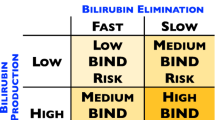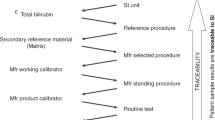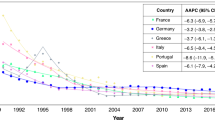Abstract
In our study, cerebrocortical electrical activity was recorded as an indicator of bilirubin neurotoxicity. Bilirubin especially affects the thalamus and cerebral cortex. Inasmuch as rhythmic oscillations on the EEG arise from the interaction between cortex and thalamus, electrophysiologic effects of bilirubin on the rhythmic oscillations with long-term postnatal age were investigated. Brain maturation was also analyzed with power spectral analysis quantitatively. For this purpose, 141 EEG records were taken (in the first week, 15th d, at the end of the first month, and at the third month) from 17 infants with hyperbilirubinemia and 22 healthy infants. In all records, the major frequency component was formed by the delta frequency in both groups. In the first records of the hyperbilirubinemia group, the delta frequency was higher than the control group; however the theta, alpha, and beta frequencies and the amplitude levels were lower (p < 0.001). These changes were found to be significantly correlated with the bilirubin levels (p < 0.001). On the 15th d the amplitude of the hyperbilirubinemia group increased to similar levels as the control group. At the frequency bands of delta and theta, there were significant changes related to postnatal age (p < 0.001). In all cerebral regions, the delta frequency decreased and the theta frequency increased with age. However, in the hyperbilirubinemia group the delta frequency was higher, the theta frequency was lower, and the changes between the groups disappeared in the third month despite the differences at all regions of the brain. In terms of the vertex, k complex, and sleep spindle, there were no differences between both groups in the third month (p > 0.05). We conclude that hyperbilirubinemia affects the cerebrocortical electrical activity but appears to be time limited.
Similar content being viewed by others
Log in or create a free account to read this content
Gain free access to this article, as well as selected content from this journal and more on nature.com
or
Abbreviations
- G6PD:
-
glucose- 6-phosphate dehydrogenase
References
Whitington PF, Gartner LW 1993 Disorders of bilirubin metabolism. In: Nathan DG, Oski FA (eds) Hematology of Infancy and Childhood. WB Saunders, Philadelphia, pp 74–114
Oski FA 1991 Disorders of bilirubin metabolism. In: Taeusch HW, Ballard RA, Avery ME (eds) Diseases of the Newborn. WB Saunders, Philadelphia, pp 749–777
Kliegman RM 1996 Jaundice and hyperbilirubinemia in the newborn. In: Nelson WE, Behrman RE, Kliegman RM, Arvin AM (eds) Textbook of Pediatrics. WB Saunders, Philadelphia, pp 493–499
Hansen TWR, Bratlid D 1986 Bilirubin brain toxicity. Acta Pediatr Scand 75: 513–522
Gartner LM, Snyder RN, Chabon RS, Bernstein J 1970 Kernicterus: high incidence in premature infants with low serum bilirubin concentrations. Pediatrics 45: 906–917
Morphis L, Constantopoulos A, Matsanıotıs N 1982 Bilirubin-induced modulation of cerebral protein phosphorylation in neonate rabbits in vivo. Science 218: 156–158
Tharp BR 1990 Electrophysiological brain maturation in premature infants: an historical perspective. J Clin Neurophysiol 7: 302–314
Dubowitz L, Dubowitz V, Goldberg C 1970 Clinical assessment of gestational age in the newborn infant. J Pediatr 77: 1–10
Robertson WO 1998 Personal reflections on the AAP practice parameter on management of hyperbilirubinemia in the healthy term newborn. Pediatr Rev 19: 75–77
Jasper HH 1958 The ten-twenty electrode system of the International Federation. Electroencephalogr Clin Neurophysiol 10: 371–373
Özmert E, Erdem G, Topçu M, Yurdakök M, Tekinalp G, Genç D, Renda Y 1996 Long-term follow-up indirect hyperbilirubinemia in full-term Turkish infants. Acta Paediatr 85: 1440–1444
Nakamura H, Takada S, Shimabuku R, Matsuo M, Matsuo T, Negishi H 1985 Auditory nerve brainstem responses in newborn infants with hyperbilirubinemia. Pediatrics 75: 703–708
Koivisto M 1987 Cry analysis in infants with Rh haemolytic disease. Acta Paediatr Scand 335: 1–73
Chen YJ, Kang WM 1995 Effects of bilirubin on visual evoked potentials in term infants. Eur J Pediatr 154: 662–666
Bongers-Schokking B, Colon EJ, Hoogland RA, Van den Brande JL, Groot CJ 1990 Somatosensory evoked potentials in neonatal jaundice. Acta Pediatr Scand 79: 148–155
Wennberg RP, Hance J 1986 Experimental bilirubin encephalopathy: importance of total bilirubin, protein binding, blood-brain barrier. Pediatr Res 20: 789–792
Szeto H 1990 Spectral edge frequency as a simple quantitative measure of the maturation of electrocortical activity. Pediatr Res 27: 289–292
Scher MS, Sun M, Steppe DA, Guthrie RD, Sclabassi RJ 1994 Comparisons of EEG spectral correlation measures between healthy term preterm infants. Pediatr Neurol 10: 104–108
Ellingson RJ, Peters JF 1980 Development of EEG daytime sleep patterns in trisomy-21 infants during the first year of life: longitudinal observations. Electroencephalogr Clin Neurophysiol 50: 457–466
Hahn JS, Tharp BR 1990 Winner of the Brazier Award: the dismature EEG pattern in infants with bronchopulmonary dysplasia its prognostic implications. Electroencephalogr Clin Neurophysiol 76: 106–113
Tharp B, Scher M, Clancy R 1989 Serial EEGs in normal abnormal infants with birth weights less than 1200 grams: a prospective study with long term follow-up. Neuropediatrics 20: 64–72
Haas GH, Prechtl HF 1977 Normal abnormal EEG maturation in newborn infants. Early Hum Dev 1: 69–90
Schulte FJ, Michaelis R, Nolte R, Albert G, Parl U, Lasson U 1969 Brain behavioral maturation in newborn infants of diabetic mothers. I. Nerve conduction EEG patterns. Neuropaediatrie 1: 24–35
Holmes GL, Lombroso CT 1993 Prognostic value of background patterns in the neonatal EEG. J Clin Neurophysiol 10: 323–352
Ktonas PY, Fagioli I, Salzarulo P 1995 Delta (0.5–1.5 Hz) sigma (11.5–15.5 Hz) EEG power dynamics throughout quiet sleep in infants. Electroencephalogr Clin Neurophysiol 95: 90–96
Parmelee AH 1969 EEG power spectral analysis of newborn infants' sleep states. Electroencephalogr Clin Neurophysiol 27: 690–691
Schulte FJ, Bell EF 1973 Bioelectric brain development: an atlas of EEG power spectra in infants young children. Neuropaediatrie 4: 30–45
Thatcher RW, Walker RA, Gludice S 1987 Human cerebral hemispheric development at different rates ages. Science 236: 1110–1113
Author information
Authors and Affiliations
Corresponding author
Rights and permissions
About this article
Cite this article
Gürses, D., Kiliç, İ. & Şahiner, T. Effects of Hyperbilirubinemia on Cerebrocortical Electrical Activity in Newborns. Pediatr Res 52, 125–130 (2002). https://doi.org/10.1203/00006450-200207000-00023
Received:
Accepted:
Issue date:
DOI: https://doi.org/10.1203/00006450-200207000-00023
This article is cited by
-
Evaluation of region selective bilirubin-induced brain damage as a basis for a pharmacological treatment
Scientific Reports (2017)



